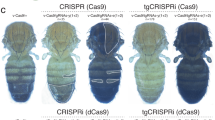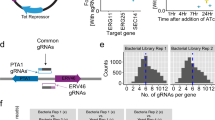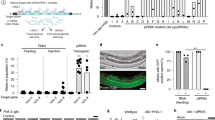Abstract
RNA interference (RNAi) in both plants and animals is mediated by small RNAs of approximately 21–23 nucleotides in length for regulation of target gene expression at multiple levels through partial sequence complementarities1,2. Combined with widespread genome sequencing, experimental use of RNAi has the potential to interrogate systematically all genes in a given organism with respect to a particular function3,4,5,6,7,8,9. However, owing to a tolerance for mismatches and gaps in base-pairing with targets10,11,12, small RNAs could have up to hundreds of potential target sequences in a genome13,14, and some small RNAs in mammalian systems have been shown to affect the levels of many messenger RNAs besides their intended targets15,16. The use of long double-stranded RNAs (dsRNAs) in Drosophila, where Dicer-mediated processing produces small RNAs inside cells, has been thought to reduce the probability of such ‘off-target effects’ (OTEs)5. Here we show, however, that OTEs mediated by short homology stretches within long dsRNAs are prevalent in Drosophila. We have performed a genome-wide RNAi screen for novel components of Wingless (Wg) signal transduction17 in Drosophila S2R + cells, and found few, if any, legitimate candidates. Rather, many of the top candidates exert their effects on Wg response through OTEs on known pathway components or through promiscuous OTEs produced by tandem trinucleotide repeats present in many dsRNAs and genes. Genes containing such repeats are over-represented in candidate lists from published screens, suggesting that they represent a common class of false positives. Our results suggest simple measures to improve the reliability of genome-wide RNAi screens in Drosophila and other organisms.
This is a preview of subscription content, access via your institution
Access options
Subscribe to this journal
Receive 51 print issues and online access
$199.00 per year
only $3.90 per issue
Buy this article
- Purchase on Springer Link
- Instant access to full article PDF
Prices may be subject to local taxes which are calculated during checkout




Similar content being viewed by others
References
Valencia-Sanchez, M. A., Liu, J., Hannon, G. J. & Parker, R. Control of translation and mRNA degradation by miRNAs and siRNAs. Genes Dev. 20, 515–524 (2006)
Zamore, P. D. & Haley, B. Ribo-gnome: the big world of small RNAs. Science 309, 1519–1524 (2005)
Moffat, J. & Sabatini, D. M. Building mammalian signalling pathways with RNAi screens. Nature Rev. Mol. Cell Biol. 7, 177–187 (2006)
Armknecht, S. et al. High-throughput RNA interference screens in Drosophila tissue culture cells. Methods Enzymol. 392, 55–73 (2005)
Echeverri, C. J. & Perrimon, N. High-throughput RNAi screening in cultured cells: a user's guide. Nature Rev. Genet. 7, 373–384 (2006)
Fraser, A. G. et al. Functional genomic analysis of C. elegans chromosome I by systematic RNA interference. Nature 408, 325–330 (2000)
Berns, K. et al. A large-scale RNAi screen in human cells identifies new components of the p53 pathway. Nature 428, 431–437 (2004)
Lum, L. et al. Identification of Hedgehog pathway components by RNAi in Drosophila cultured cells. Science 299, 2039–2045 (2003)
Paddison, P. J. et al. A resource for large-scale RNA-interference-based screens in mammals. Nature 428, 427–431 (2004)
Doench, J. G. & Sharp, P. A. Specificity of microRNA target selection in translational repression. Genes Dev. 18, 504–511 (2004)
Haley, B. & Zamore, P. D. Kinetic analysis of the RNAi enzyme complex. Nature Struct. Mol. Biol. 11, 599–606 (2004)
Brennecke, J., Stark, A., Russell, R. B. & Cohen, S. M. Principles of microRNA-target recognition. PLoS Biol. 3, e85 (2005)
Lewis, B. P., Burge, C. B. & Bartel, D. P. Conserved seed pairing, often flanked by adenosines, indicates that thousands of human genes are microRNA targets. Cell 120, 15–20 (2005)
Lim, L. P. et al. Microarray analysis shows that some microRNAs downregulate large numbers of target mRNAs. Nature 433, 769–773 (2005)
Birmingham, A. et al. 3′ UTR seed matches, but not overall identity, are associated with RNAi off-targets. Nature Methods 3, 199–204 (2006)
Jackson, A. L. et al. Expression profiling reveals off-target gene regulation by RNAi. Nature Biotechnol. 21, 635–637 (2003)
Logan, C. Y. & Nusse, R. The Wnt signaling pathway in development and disease. Annu. Rev. Cell Dev. Biol. 20, 781–810 (2004)
Veeman, M. T., Slusarski, D. C., Kaykas, A., Louie, S. H. & Moon, R. T. Zebrafish prickle, a modulator of noncanonical Wnt/Fz signaling, regulates gastrulation movements. Curr. Biol. 13, 680–685 (2003)
Boutros, M. et al. Genome-wide RNAi analysis of growth and viability in Drosophila cells. Science 303, 832–835 (2004)
Zeng, W. et al. naked cuticle encodes an inducible antagonist of Wnt signalling. Nature 403, 789–795 (2000)
DasGupta, R., Kaykas, A., Moon, R. T. & Perrimon, N. Functional genomic analysis of the Wnt-wingless signaling pathway. Science 308, 826–833 (2005)
Mosimann, C., Hausmann, G. & Basler, K. Parafibromin/Hyrax activates Wnt/Wg target gene transcription by direct association with β-catenin/Armadillo. Cell 125, 327–341 (2006)
Banziger, C. et al. Wntless, a conserved membrane protein dedicated to the secretion of Wnt proteins from signaling cells. Cell 125, 509–522 (2006)
Bartscherer, K., Pelte, N., Ingelfinger, D. & Boutros, M. Secretion of Wnt ligands requires Evi, a conserved transmembrane protein. Cell 125, 523–533 (2006)
Jackson, A. L. & Linsley, P. S. Noise amidst the silence: off-target effects of siRNAs? Trends Genet. 20, 521–524 (2004)
Lin, X. et al. siRNA-mediated off-target gene silencing triggered by a 7 nt complementation. Nucleic Acids Res. 33, 4527–4535 (2005)
Acknowledgements
We thank N. Perrimon and colleagues for their role in producing the dsRNA library, S. Yao for initial assistance in the Hh screen, and R. Gong for technical assistance. We also thank all members of the Beachy laboratory, R. Green and S. Dorner for helpful discussions, and G. Seydoux and J. Taipale for critical comments on the manuscript.
Author information
Authors and Affiliations
Corresponding author
Ethics declarations
Competing interests
Reprints and permissions information is available at www.nature.com/reprints. The authors declare no competing financial interests.
Supplementary information
Supplementary Notes
This file contains Supplementary Methods, Supplementary Figures 1–8, Supplementary Tables 1–5, and Supplementary List (Alignment between Wg screen candidates with known pathway components). (PDF 514 kb)
Rights and permissions
About this article
Cite this article
Ma, Y., Creanga, A., Lum, L. et al. Prevalence of off-target effects in Drosophila RNA interference screens. Nature 443, 359–363 (2006). https://doi.org/10.1038/nature05179
Received:
Accepted:
Published:
Issue Date:
DOI: https://doi.org/10.1038/nature05179
This article is cited by
-
Chronos: a cell population dynamics model of CRISPR experiments that improves inference of gene fitness effects
Genome Biology (2021)
-
A sequence complementarity-based approach for evaluating off-target transcript knockdown in Bombus terrestris, following ingestion of pest-specific dsRNA
Journal of Pest Science (2021)
-
CRISPR-Cas9-based mutagenesis frequently provokes on-target mRNA misregulation
Nature Communications (2019)
-
An efficient and multiple target transgenic RNAi technique with low toxicity in Drosophila
Nature Communications (2018)
-
Evaluation and control of miRNA-like off-target repression for RNA interference
Cellular and Molecular Life Sciences (2018)
Comments
By submitting a comment you agree to abide by our Terms and Community Guidelines. If you find something abusive or that does not comply with our terms or guidelines please flag it as inappropriate.



